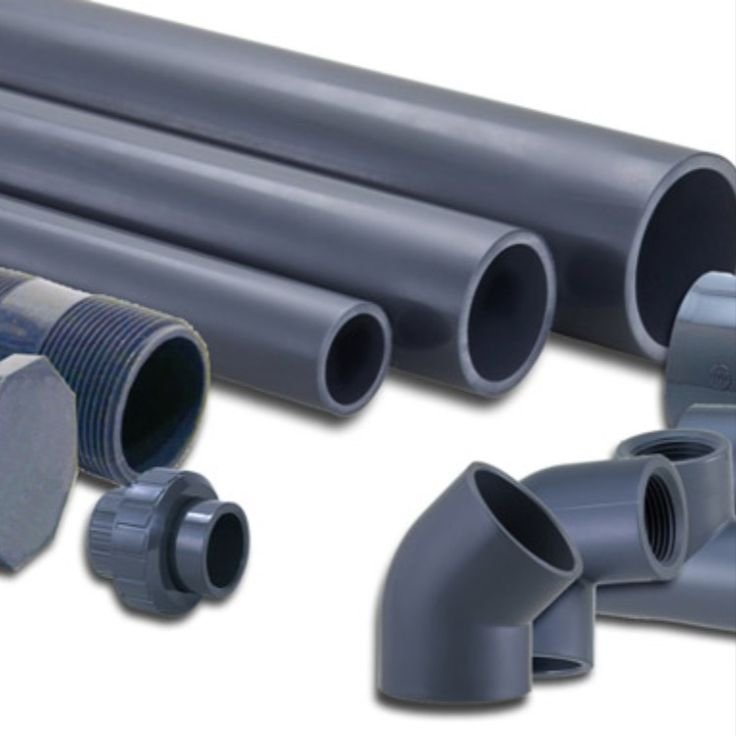Plumbing systems are the lifeline of every building, whether residential, commercial, or industrial. As technology advances, homeowners and builders are turning toward more durable, cost-effective, and efficient materials. Among all the available options, CPVC pipes have emerged as one of the most reliable and long-lasting choices.
In this detailed guide, we’ll explore what CPVC pipes are, their advantages, applications, installation process, and why they’ve become the preferred choice for modern plumbing worldwide.
🧱 What Are CPVC Pipes?
CPVC (Chlorinated Polyvinyl Chloride) pipes are thermoplastic pipes made through a process where PVC (Polyvinyl Chloride) resin is chlorinated. This chlorination enhances the pipe’s heat resistance, strength, and chemical durability, making it suitable for both hot and cold water applications.
Key Features:
-
High chlorine content for superior heat tolerance
-
Resistance to corrosion and scaling
-
Long service life (up to 50 years or more)
-
Lightweight yet strong structure
-
Smooth inner surface for uninterrupted water flow
In simple terms, CPVC pipes combine the best of both worlds — the durability of metal and the lightweight flexibility of plastic.
⚙️ Why CPVC Over Other Materials?
Traditional plumbing materials like metal, copper, and PVC have their own limitations — corrosion, rusting, or poor temperature handling. CPVC eliminates all those issues.
| Property | CPVC | PVC | Copper | Galvanized Iron |
|---|---|---|---|---|
| Temperature Resistance | Up to 93°C | Up to 60°C | Excellent | Moderate |
| Corrosion Resistance | Excellent | Good | Moderate | Poor |
| Durability | 50+ years | 25–30 years | 20–25 years | 10–15 years |
| Cost | Affordable | Low | Expensive | Moderate |
| Maintenance | Minimal | Moderate | High | High |
The ability to handle hot water and resist chemical reactions makes CPVC an ideal choice for a wide range of applications.
🏠 Applications of CPVC Pipes
The versatility of CPVC pipes allows them to be used across multiple sectors.
1. Residential Plumbing
-
Hot and cold water supply lines
-
Bathroom fittings and kitchen pipelines
-
Connections for water heaters and washing machines
2. Commercial Buildings
-
Hotels, hospitals, and office complexes
-
HVAC systems and centralized water lines
3. Industrial Systems
-
Chemical processing plants
-
Water treatment and filtration units
-
Food and beverage manufacturing units
4. Fire Protection Systems
CPVC’s flame-retardant nature makes it a top choice for fire sprinkler systems. It doesn’t support combustion and emits low smoke during high heat, ensuring safety and reliability.
5. Agriculture and Irrigation
Due to its chemical resistance, CPVC is used in irrigation systems, fertilizers, and pesticide distribution pipelines.
🔩 Advantages of Using CPVC Pipes
The popularity of CPVC pipes isn’t just a trend — it’s backed by solid technical and practical benefits.
1. Exceptional Heat Resistance
CPVC pipes can withstand high temperatures up to 200°F (93°C), making them ideal for hot water supply in both homes and industries.
2. Corrosion-Free Performance
Unlike steel or copper, CPVC doesn’t rust or corrode. This ensures clean, pure, and uncontaminated water flow.
3. Chemical Resistance
CPVC pipes remain unaffected by acids, alkalis, and salts — making them ideal for chemical industries and water treatment plants.
4. Lightweight and Easy to Install
They’re much lighter than metal pipes and can be installed easily using solvent cement joints, saving both time and labor costs.
5. Safe for Drinking Water
CPVC is non-toxic and certified safe for potable water under NSF and ASTM standards.
6. Long Lifespan
With proper installation, CPVC plumbing systems last for over 50 years without major maintenance.
7. Energy Efficient
Low thermal conductivity means hot water remains hot longer, reducing energy costs.
8. Cost-Effective
Compared to copper and PEX, CPVC offers the same reliability at a fraction of the price.
🧰 Installation Process for CPVC Pipes
Installing CPVC pipes is quick, simple, and doesn’t require special tools. Here’s how professionals do it:
Step 1: Cutting
Cut the pipe squarely using a cutter or fine-tooth saw.
Step 2: Cleaning
Remove burrs and dust using sandpaper or a clean cloth.
Step 3: Cementing
Apply CPVC solvent cement evenly on both the pipe and fitting.
Step 4: Joining
Insert the pipe into the fitting while twisting slightly to spread the cement evenly.
Step 5: Curing
Allow the joint to set for 15–20 minutes before pressure testing, and wait at least 24 hours before using the system.
✅ Pro Tip: Always use CPVC-specific solvent cement for a strong, leak-proof bond.
🔥 CPVC in Fire Protection Systems
Safety is a top priority in modern construction, and CPVC fire sprinkler systems are a proven, reliable solution.
Advantages include:
-
Resistance to ignition and flame spread
-
No corrosion or scaling
-
Lower installation cost than steel systems
-
Smooth internal surface for consistent water pressure
-
Approved by international fire safety standards (UL, FM, NSF)
CPVC sprinkler systems are widely used in hotels, hospitals, warehouses, and residential high-rises.
🧪 Technical Properties of CPVC
| Property | Value |
|---|---|
| Material | Chlorinated Polyvinyl Chloride |
| Max Working Temperature | 93°C (200°F) |
| Density | 1.56 g/cm³ |
| Thermal Conductivity | 0.19 W/m·K |
| Pressure Rating | 450 PSI (varies by size) |
| Lifespan | 50+ years |
These impressive numbers show why CPVC is the top choice for sustainable plumbing.
🌍 Environmental Impact
As sustainability becomes a key concern, CPVC pipes are proving to be eco-friendly too.
-
Low Carbon Footprint: Requires less energy during manufacturing.
-
Recyclable: Can be repurposed after its service life.
-
Water-Safe: Doesn’t release harmful toxins.
-
Durability: Reduces replacement waste.
Using CPVC helps builders and contractors meet green building standards while ensuring long-lasting performance.
🧩 CPVC Pipe Fittings
To ensure a complete system, CPVC comes with a range of fittings and accessories such as:
-
Elbows (45° & 90°)
-
Tees and Cross fittings
-
Couplings and Unions
-
End caps and reducers
-
Valves and flanges
Each fitting is made of the same CPVC material to maintain performance consistency and leak-proof joints.
🧠 Maintenance Tips for CPVC Systems
Even though CPVC requires minimal maintenance, here are a few tips to enhance its lifespan:
-
Avoid physical impacts on exposed pipes.
-
Use proper insulation for outdoor installations.
-
Regularly inspect joints and valves for leaks.
-
Flush the lines after long inactivity.
-
Keep pipes away from open flame or direct sunlight.
By following these tips, your CPVC plumbing can last for decades without any issues.
⚠️ Common Mistakes to Avoid
To ensure a flawless CPVC system, avoid the following mistakes:
-
Using PVC solvent cement instead of CPVC cement.
-
Ignoring curing time after installation.
-
Over-tightening threaded fittings.
-
Exposing CPVC to UV rays without protection.
Avoiding these will prevent leaks and ensure a strong, long-lasting plumbing network.
🧮 CPVC Pipe Sizes and Pressure Ratings
| Pipe Size (Inches) | Pressure Rating (PSI) | Common Use |
|---|---|---|
| ½” | 450 | Domestic water lines |
| ¾” | 400 | Bathrooms & kitchens |
| 1” | 370 | Main lines |
| 2” | 280 | Commercial use |
| 4” | 220 | Industrial systems |
Always match pipe size with water pressure and flow requirements for optimal results.
🔍 Comparing CPVC with PEX and HDPE
| Property | CPVC | PEX | HDPE |
|---|---|---|---|
| Hot Water Use | Excellent | Good | Moderate |
| Chemical Resistance | Excellent | Fair | Good |
| Cost | Affordable | Moderate | Moderate |
| Durability | 50+ years | 40 years | 30 years |
| Installation | Easy (solvent) | Easy (crimp) | Moderate |
Overall, CPVC offers superior heat tolerance and chemical resistance, making it ideal for both household and industrial use.
🧠 Interesting Facts About CPVC
-
CPVC was first introduced in the 1950s.
-
It can handle pH levels between 2 and 12.
-
Used in over 70 countries for residential and commercial plumbing.
-
It’s non-toxic and safe for human consumption.
🛒 How to Choose the Best CPVC Pipes
Before purchasing CPVC pipes, consider these factors:
-
Brand Reputation: Choose reliable manufacturers with proven quality.
-
Certifications: Look for ASTM, ISI, or NSF certifications.
-
Compatibility: Use matching fittings and cement.
-
Warranty: Go for products with long-term warranties.
-
Size & Pressure: Select according to application requirements.
Investing in high-quality CPVC ensures durability and peace of mind.




Leave a Reply